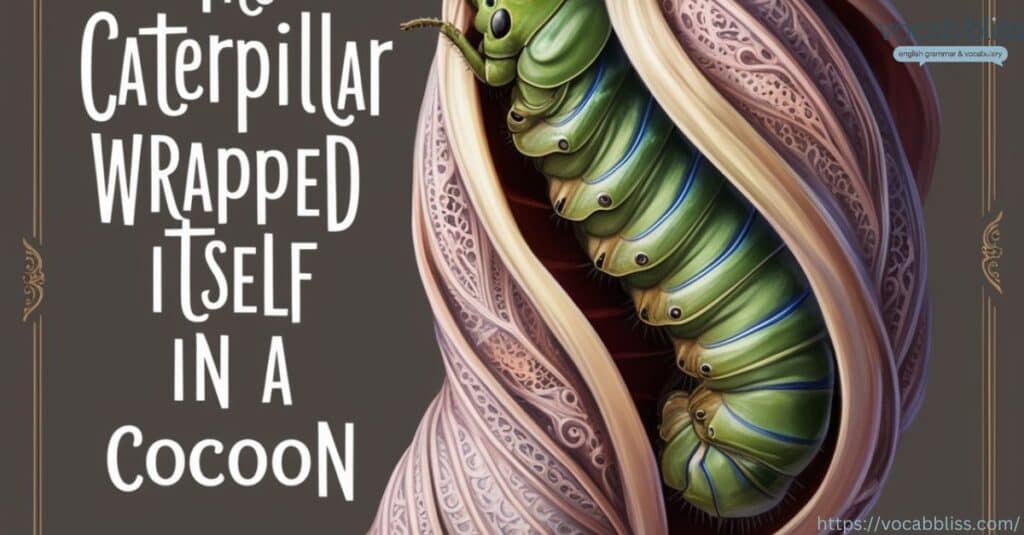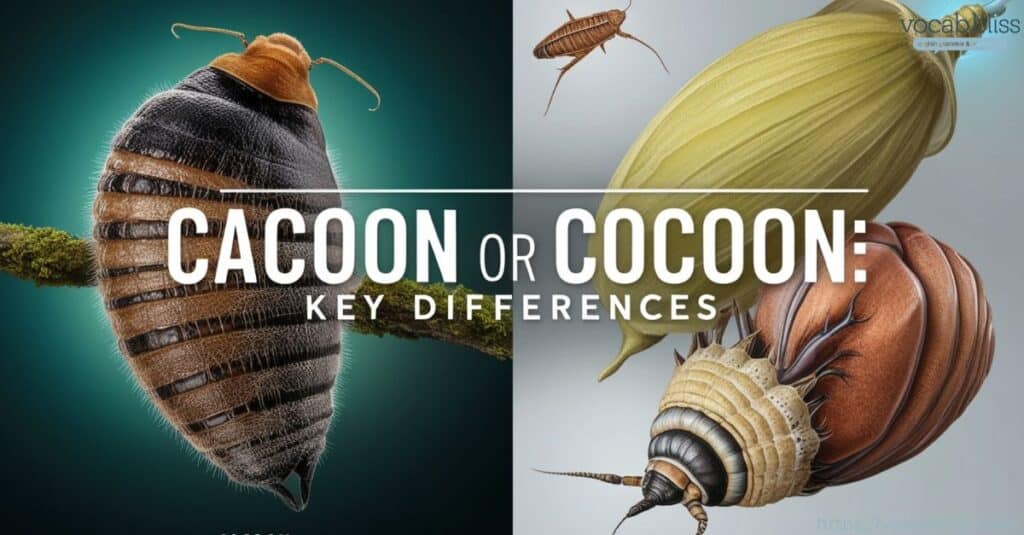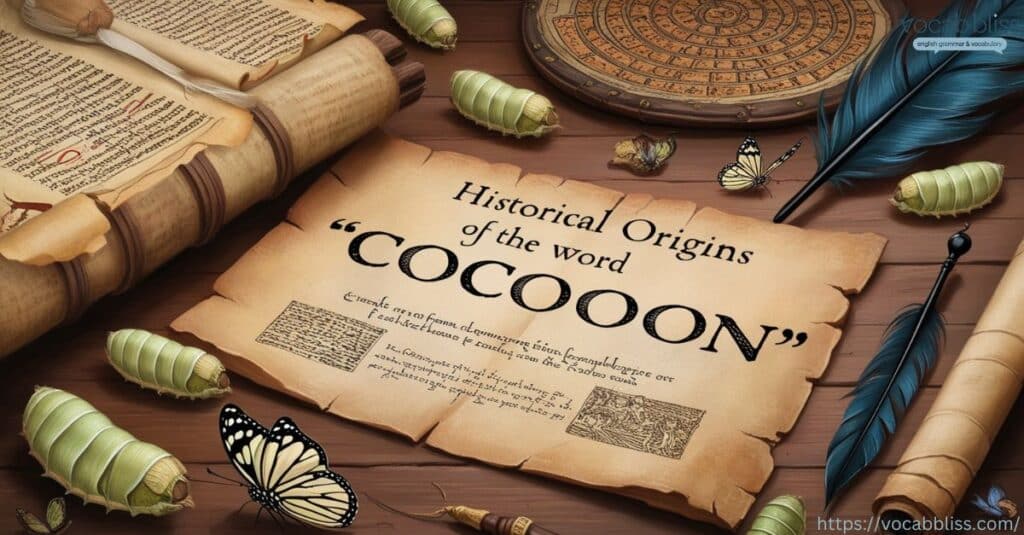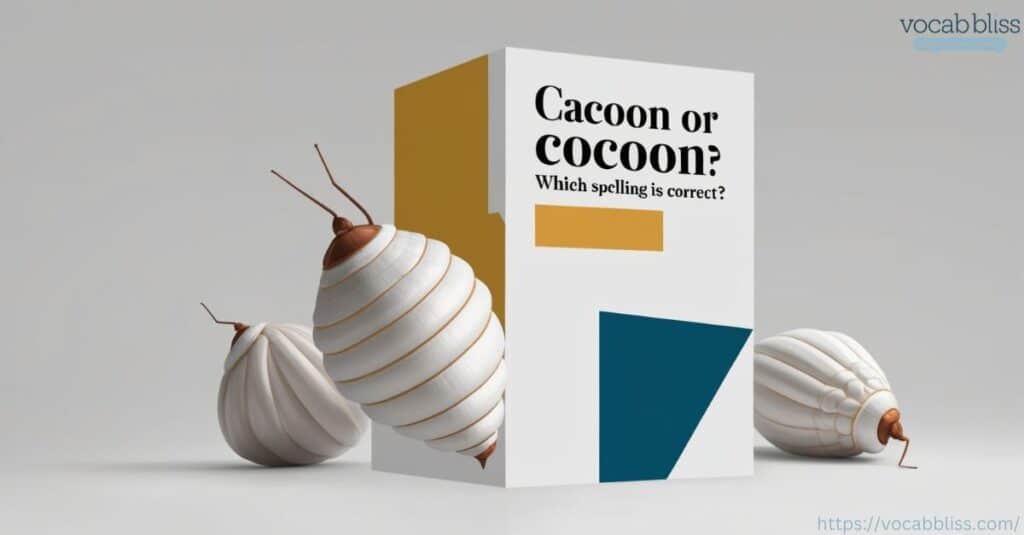Have you ever found yourself typing “cacoon or cocoon” and wondered whether you’re making a mistake or if both spellings are acceptable? You’re not alone! Many people struggle with this very question, and it’s understandable. After all, both words sound almost identical when spoken aloud, which leads to confusion.
In this article, we’ll explore the key differences between cacoon vs cocoon, explain why cocoon is the correct spelling, and help you understand when and why the mistake of using cacoon occurs.By the end of this article, you’ll have a solid understanding of the correct spelling and usage of these words, along with some tips to avoid common spelling mistakes in the future. Let’s dive in!
Understanding the Confusion Between Cacoon and Cocoon
It’s easy to see how the confusion between cacoon and cocoon happens. In casual writing, social media posts, or fast typing, many people mistakenly write cacoon because it sounds very similar to spell cocoon. The two words are pronounced the same, which leads to the natural assumption that cacoon is just an acceptable variant.
However, spell cacoon is not a recognized word in the English language. In fact, it is a misspelling of cocoon. When you see cacoon, it’s almost certainly a typing error or an oversight. As you’ll see in this article, using cocoon is the only proper choice, whether you’re talking about a silky insect covering or using it metaphorically.
Quick Summary
In this article, we explored the fascinating world of cocoons, highlighting their crucial role in the biological processes of insects undergoing metamorphosis. The cocoon serves as a protective covering that shields the developing pupa from environmental threats, predators, and other dangers. Made primarily of silk or other materials, the cocoon allows insects like caterpillars and silkworms to undergo dramatic transformations from larvae to adult forms. Its structure varies by species, but its fundamental purpose remains the same: to provide safety and stability during one of nature’s most complex processes. Additionally, the cocoon has evolved as an essential survival mechanism and holds symbolic significance in many cultures. By understanding the biological meaning of a cocoon, we gain insight into both the physical and metaphorical power of transformation in the natural world.
What is a Cacoon?
First things first: what is a cacoon? The answer might surprise you—it’s not a legitimate word. While cocoon is widely used, cacoon is a common misspelling and has no formal definition in the dictionary.
Even though some people mistakenly use cacoon, it doesn’t have a place in the English language. If you’ve seen the term cacoon used somewhere, it’s almost certainly an error, and the intended word was cocoon. If you’re writing for an academic paper, blog post, or any other formal setting, you should never use cacoon. Instead, stick to the correct spelling, cocoon.
For example, here’s how the term cacoon might mistakenly be used in a sentence:
- Incorrect: “The caterpillar wrapped itself in a cacoon.”
- Correct: “The caterpillar wrapped itself in a cocoon.”

See the difference? Cacoon doesn’t make sense in this context, while cocoon clearly conveys the meaning of the protective covering.
What is a Cocoon?
Now, let’s look at the correct term: cocoon. A cocoon refers to the protective casing that some insects, such as caterpillars, moths, or silkworms, create around themselves during the pupal stage of their life cycle. This structure shields them while they undergo metamorphosis—the process by which they transform into their adult forms, such as butterflies or moths.
Biological Meaning of Cocoon
In the natural world, few processes are as fascinating and intricate as metamorphosis, the process by which insects transform from larvae or juvenile forms into their adult stages. A key player in this process is the cocoon.
This silken or protective covering plays a pivotal role in the development of various insects, such as caterpillars, silkworms, and other species undergoing complete metamorphosis. Understanding the biological meaning of a cocoon involves exploring its role in the insect life cycle, how it’s produced, and its evolutionary significance.. For example:
- A caterpillar spins a cocoon to protect itself while it changes into a butterfly.
- Silkworms produce a cocoon to encase themselves before emerging as moths.
Metaphorical Meaning of Cocoon
Outside of biology, cocoon also has a metaphorical meaning. It can refer to any space or situation where someone feels protected, sheltered, or isolated. It symbolizes comfort and transformation. You might hear people refer to a cozy, private area as their cocoon or describe an emotional or psychological state of isolation as a cocoon.
For example, in everyday language:
- “After a long day, I retreat to my cozy cocoon of blankets.”
- “The writer created a mental cocoon to focus on his work without distractions.”
This metaphorical use is common in literature, poetry, and personal expression. A cocoon here represents a safe, comfortable space—a temporary retreat from the outside world.
Cacoon or Cocoon: Key Differences

Explore further: Of Course or Ofcourse: Which One Should You Use?
While cocoon or cacoon might seem similar at first glance, there are several key differences between them that are important to understand.
Spelling
The most obvious difference between cocoon or cacoon is the spelling. Cocoon is the correct spelling, while cacoon is simply a mistake. The extra “a” in cacoon doesn’t belong, and if you want your writing to be accurate and professional, you should always use cocoon.
Meaning
- Cocoon: Refers to a protective casing that certain insects create during the pupal stage. It can also be used metaphorically to represent a protective space or state of isolation.
- Cacoon: Has no meaning, as it is an incorrect spelling of cocoon. It’s a spelling mistake, plain and simple.
Usage
- Cocoon is used in both literal and figurative contexts. When referring to the insect stage, the term is used widely in biology. In a more figurative sense, it’s used to describe a safe, private, or transformative space or situation.
- Cacoon, on the other hand, should never be used. It’s a mistake and will detract from the professionalism and clarity of your writing.
Example of Correct and Incorrect Usage
- Correct: “The caterpillar spun a cocoon around itself to begin its transformation.”
- Incorrect: “The caterpillar spun a cacoon around itself to begin its transformation.”
In the second example, cacoon is clearly a mistake. The word cocoon is the one you need to use.
Common Mistakes: Why People Get “Cacoon” Wrong
If you’re wondering why so many people get cacoon wrong, you’re not alone. There are a few common reasons behind this mistake:
- Phonetic Similarity
The main reason people mistakenly write cacoon is because of the phonetic similarity between the two words. When spoken aloud, cocoon sounds like it could be spelled with an “a,” much like balloon or raccoon. As a result, some people naturally write cacoon, thinking it’s the correct spelling. - Autocorrect and Typographical Errors
When typing quickly, it’s easy to hit an extra letter by mistake. You might type cocoon correctly, but autocorrect may change it to cacoon, or you might accidentally press the “a” key instead of the “o” key. - Lack of Proofreading
In informal settings—like social media posts or casual emails—many people don’t take the time to proofread their writing. As a result, common misspellings like cacoon go unnoticed. In professional writing, however, such errors can undermine the quality and credibility of your work.
Correct Examples of “Cocoon” in Context
Now that we’ve established the importance of cocoon spelling, let’s explore some examples where cocoon is used both literally and metaphorically.
In Literature and Metaphor

In literature, cocoon often symbolizes a process of transformation, growth, or protection. For example, the character may retreat into a physical or mental cocoon in times of change or difficulty.
- “The protagonist locked herself in her room, seeking refuge in her personal cocoon as the world outside fell apart.”
- “He slowly emerged from his emotional cocoon, ready to face the challenges ahead.”
These examples use cocoon as a metaphor to describe emotional or psychological states.
In Everyday Language
In everyday language, cocoon can also describe a cozy, protective physical space. For example:
- “I’m going to curl up in my cocoon of blankets and watch a movie.”
- “The little girl felt safe in her cocoon of stuffed animals.”
In these examples, cocoon is used to evoke feelings of warmth and safety. It’s a comforting term that’s not just for biology but for everyday situations as well.
The Origins of “Cocoon”
To fully understand the word cocoon, we need to explore its origins. Where does it come from, and how did it become such a widely used term?
Historical Origins of the Word “Cocoon”

The word cocoon comes from the French term cocon, which means “a small case” or “a covering.” The Latin equivalent, coconus, also means “chrysalis.” These roots refer to the idea of a protective covering that encases something vulnerable, like an insect undergoing metamorphosis.
The term cocoon was first used in English in the 17th century, and its usage expanded over time to include both the biological and metaphorical meanings that we use today.
The Evolution of the Misspelling Cacoon
The misspelling cacoon likely arose due to the influence of words like balloon, raccoon or baboon, which all contain the double “o” spelling. This phonetic pattern may have led people to incorrectly assume that cocoon should follow the same pattern.
In fact, cacoon was never part of the original term, and it has no place in standard English usage. As time went on, writers, especially in informal contexts, may have started using cacoon as a variation, but it has no real legitimacy.
Conclusion: The Final Word on Cacoon or Cocoon
In conclusion, cocoon is the correct spelling when referring to the protective casing spun by insects during metamorphosis or when used metaphorically to describe a safe, isolated space. Cacoon, on the other hand, is simply a misspelling and has no recognized meaning in the English language.
By understanding the difference between these two words, you’ll not only improve your spelling but also ensure that your writing remains clear, professional, and accurate. Whether you’re writing about biology or using the word metaphorically, cocoon is the word to use.
Now that you’ve learned the key differences between cacoon and cocoon, you’ll be equipped to avoid this common mistake in your own writing. Always remember to proofread your work carefully, and when in doubt, refer back to trusted sources like a dictionary to confirm the correct spelling. Happy writing!
This revised article is a detailed, comprehensive exploration of the topic cacoon vs cocoon, with the goal of meeting your desired word count and maintaining clarity, structure, and valuable content throughout.
Dive Deeper:
- Totalling or Totaling: Which Spelling Should You Use?
- Hoodie or Hoody? Choosing the Right Spelling
- Occasion or Ocassion: What’s the Correct Spelling?
- Long Term or Long-Term: Right Decision in Writing

Jorge Phillips is an experienced blogger who writes for Vocab Bliss, sharing his passion for the English language. With a knack for simplifying complex grammar rules and a focus on commonly confused words, Jorge helps readers navigate the nuances of English with ease. His insights aim to make learning engaging and practical.







